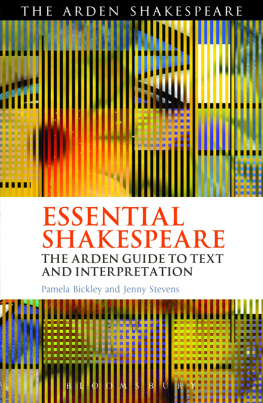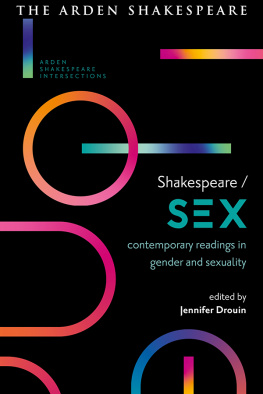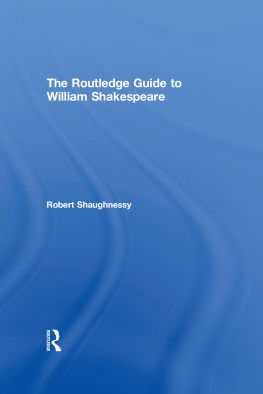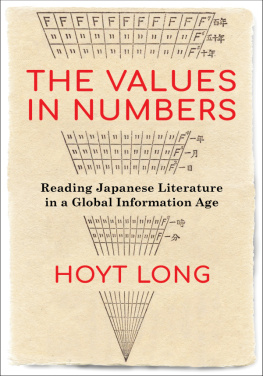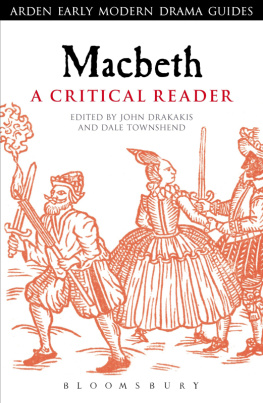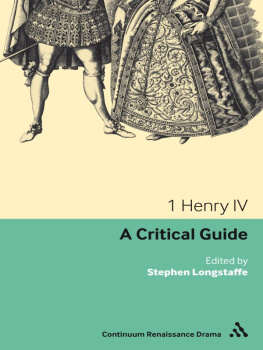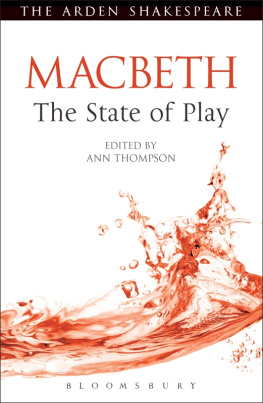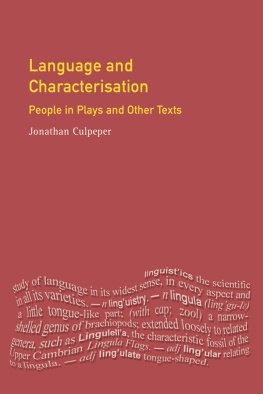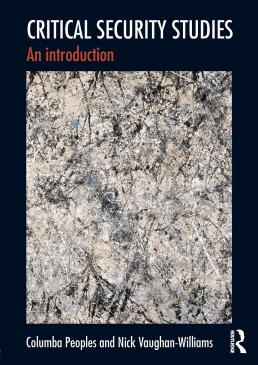RELATED TITLES
Doing Shakespeare, Revised Edition , Simon Palfrey
Shakespeare and Contemporary Theory , Neema Parvini
Shakespeare Thinking , Philip Davis
Essential
Shakespeare
The Arden Guide to
Text and Interpretation
Pamela Bickley and
Jenny Stevens
Contents
How to use
this book
The purpose of this book is to introduce students new to undergraduate Shakespeare study to fourteen of the most commonly studied plays. Significant areas of recent critical debate are introduced, explained and put into practice, and the contexts in which the plays were written and performed are explored. Worked examples of close analysis demonstrate different ways of approaching both text and performance.
Each chapter is arranged through four discrete sections:
critical theory and practice
early modern contexts
close reading
performance and production
These sections can be read horizontally across the book, giving a comprehensive overview of each of these aspects of Shakespeare studies. At the same time, individual chapters provide a thought-provoking way in to the play itself.
The Further Thinking section at the foot of each chapter offers suggestions for making connections across texts and for trying out some of the critical approaches discussed. Each chapter concludes with Afterlives: brief references to some of the re-inventions of the plays as entirely new works of art.
One of the challenges involved in moving from pre-university to undergraduate study is shifting away from an intense focus on a relatively narrow range of prose, poetry and drama texts to a more expansive study of topic areas, not necessarily organized by work or author. This broadening out includes becoming familiar with a variety of critical perspectives and their terminologies. First encounters with contemporary criticism can be disorientating, akin to arriving in an unknown country. Its language can be formidably technical and its conceptual underpinnings can seem rather foreign, derived as they sometimes are from knowledge areas such as the natural and human sciences. However, getting to grips with the ideas and idiom of modern criticism and with the increasingly interdisciplinary nature of literary study is an important part of undergraduate learning. Each chapter of this book offers a brief introduction to one critical approach at work in current Shakespeare studies, followed by a practical example. Some critical practices have been selected for their undisputed influence on Shakespearean scholarship, while others have been included to represent new and emerging fields of interpretation.
The organization of the book means that the fourteen critical approaches demonstrated appear as discrete academic fields. The truth is, though, that what are often presented as separate schools of thought, regularly cross their own perceived borders, branching out to form new and highly stimulating modes of interpretation. Academic readings of Shakespeare can also be highly combative (indeed, critical discourse is sometimes described in terms of wars, battles and conflict). Yet whether friendly or hostile, critical approaches are constantly in dialogue with each other, ensuring that literary scholarship never grows complacent or falls behind the times.
Each chapter opens with what is no more than a snapshot of a particular reading approach and a demonstration of how it might be applied to the Shakespeare text. Taken in their entirety, these sections offer an overview of critical practice a starting point from which readers can negotiate their way through competing viewpoints to form their own responses. Given the status of Shakespeare today, the body of secondary writings about the plays is vast and contains within it a complex and fascinating history of interprative reading. While this book focuses primarily on a range of current critical methods and writings, it also takes into account formative opinions from the mid-seventeenth century onwards, thus developing an awareness of how views of the works have changed as societies have changed and underlining the importance of situating critical writings in the political, social and historical contexts in which they were produced. As you build up and refine your knowledge of criticism now and over time, so you will be increasingly able to map, situate and contextualize the shifts of interpretation which have driven, and continue to drive, Shakespearean scholarship.
Shakespeare lived at a highly exciting but unstable and dangerous period of history now usually termed early modern, although it is also referred to as the Renaissance or the Reformation. This book introduces a range of cultural contexts: some specifically theatrical such as Shakespeares sources, traditions of revenge tragedy, boy players; others tackling significant issues of the times kingship, religion, sexuality, the family. Shakespeares plays were written and performed during the Protestant Reformation: Henry VIIIs break with Roman Catholicism and Papal authority. The religious changes begun before Shakespeares birth had profound effects for the whole of his lifetime, not least because of the violent deaths suffered by those who refused to renounce their Catholic beliefs or, in the reign of Mary, those who could not in conscience, return to Rome. It was a turbulent time; highly conscious of theological debate, in part because of the new availability of biblical text in translation. Religious belief was taken for granted and modern attitudes of pluralism, indifference or complete rejection would have been unimaginable. Many in Shakespeares audience must have wrestled, like Hamlet, with thoughts beyond the reaches of [their] souls.
The Renaissance is a concept connoting vigorous rejuvenation. The re-birth it implies is the rediscovery of classical (particularly Greek) texts, chiefly literary and philosophical, and the influence of classical models on the aesthetic world of literature, architecture and painting. William Goldings 1567 translation of Ovids Metamorphoses is an excellent example of a classical text Shakespeare knew well and drew on frequently. Innovations in methods of production and dissemination made books such as these newly affordable and accessible, communicating ideas beyond national borders.
Early modern, by definition, sounds progressive, as if anticipating or becoming a modern age. It is certainly a period associated with the expansion of geographical and scientific knowledge. In Twelfth Night Maria refers to the new map with the augmentation of the Indies; clearly there was widespread awareness that the world was expanding and changing. Scientific enquiry was increasingly investigative and analytical; Rembrandts painting of an anatomy lesson shows how medical knowledge was advancing through empirical method. But it would be misleading to characterize the early seventeenth century as ushering in a bright new age of social progress. The limitations of early modern as a term include its Eurocentrism and its limitations in terms of class, race and gender. It was often an oppressive and punitive period. London, a thriving urban world of publishing, commerce and theatre was also subject to periodic devastating plagues. Nonetheless, the late sixteenth- and early seventeenth-century world is distinctive and Shakespeare is intrinsically involved in it: his poetry and plays demonstrate his involvement with significant events and ideas of his age. His theatre is part of the commodity culture of the time, disseminating ideas as well as entertaining every class of Londons world.

